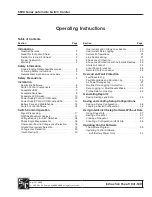
14 S&C Instruction Sheet 1041-540
Installation
The switch control continuously monitors the battery voltage. In addition, it tests the
battery at regular, scheduled intervals. The interval depends on the power conditions:
• During battery discharge, the test is run hourly.
• After a power outage, the test is run every two hours for 24 hours to monitor the bat-
tery status while the battery is recharged.
• After 24 hours of continuous operation on ac power (or power from the sensors, if
applicable), the test is run once a day.
Note:
The BATTERY TEST/LAMP TEST switch or a SCADA command can be used to
manually test the battery at any time.
During the battery test, the switch control applies various loads to the battery to
determine how it will perform under load. These tests include:
Actual battery voltage
. Determines the true open circuit battery voltage
Battery impedance
. Determines the internal impedance of the battery
Calculated voltage under load
. Determines the minimum voltage predicted during
switch operation (When the switch control is operating on battery power, the control
reevaluates this “calculated voltage under load” continuously. Otherwise, it evaluates
this value only during battery test cycles.)
Based on the results of the above monitoring and tests, the switch control may take
the following actions:
• If the battery “calculated voltage under load” drops below the
Battery Low
value,
the switch control displays a “Battery Low” message and turns on the faceplate
BATTERY LOW LED. (At voltages below this value, switch operation is still possible
but only for a limited time.)
• If the “calculated voltage under load” drops below the
Battery Bad
value, the
switch control sets the
Battery Bad
status indication for the SCADA operator and
displays a “Battery Bad” message on certain IntelliLink software screens. (The
switch will not reliably operate at voltages below this value.)
• If the battery steady-state voltage drops below 22 Volts (for a 24-Vdc battery) or 33
volts (for a 36-Vdc battery) while the switch control is operating on battery power,
the switch control automatically disconnects all loads to prevent deep discharge.
Power is restored to loads once ac power (or sensor power, if applicable) is restored
or the battery is replaced.
• If the battery voltage falls outside the proper range (20-30.5 Volts for 24-Vdc batter-
ies, 30-45.75 Volts for 36-Vdc batteries) while the switch control is operating on ac
power (or sensor power, if applicable), the switch control disconnects the battery
from the system and turns off the BAT ON LED on the Power Supply/Control I/O
module.
Because the battery is used for the wetting voltage of certain switch status contacts,
disconnecting the battery will also generate alarms.
Based on field experience, a weak battery may fail the battery test in very cold tem-
peratures but pass when the ambient temperature rises. If a
Battery Low
or
Battery
Bad
alarm occurs, schedule the battery for replacement. In warmer climates or seasons,
if a battery test indicates a
Battery Low
condition, the battery may last 1-2 weeks longer.





























